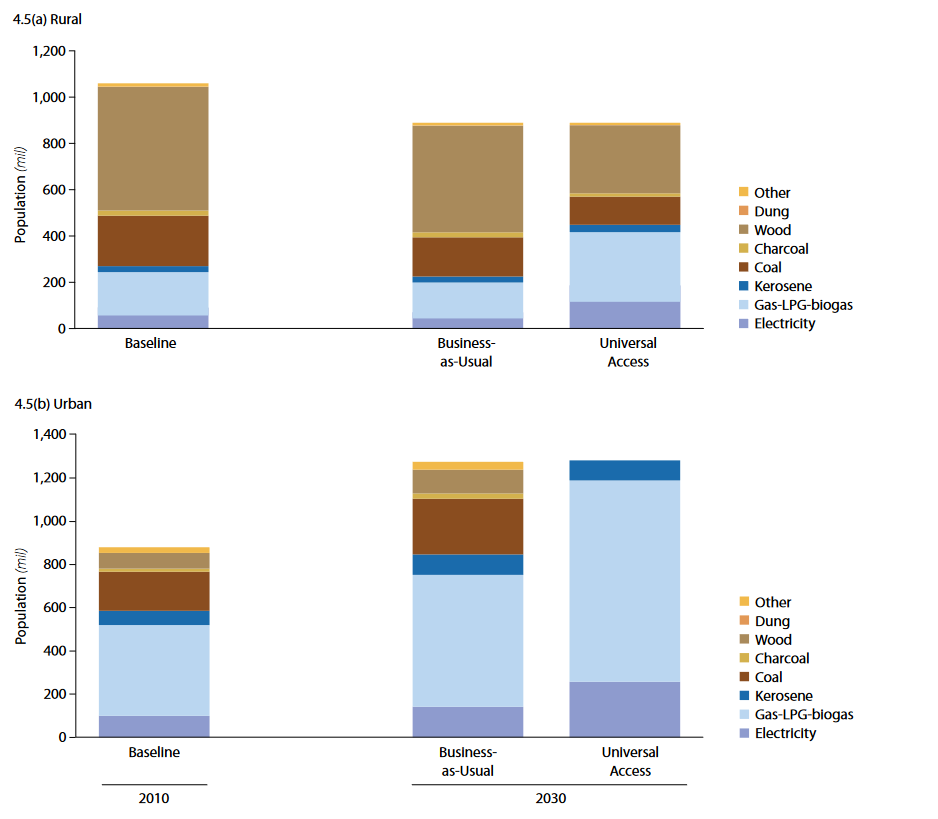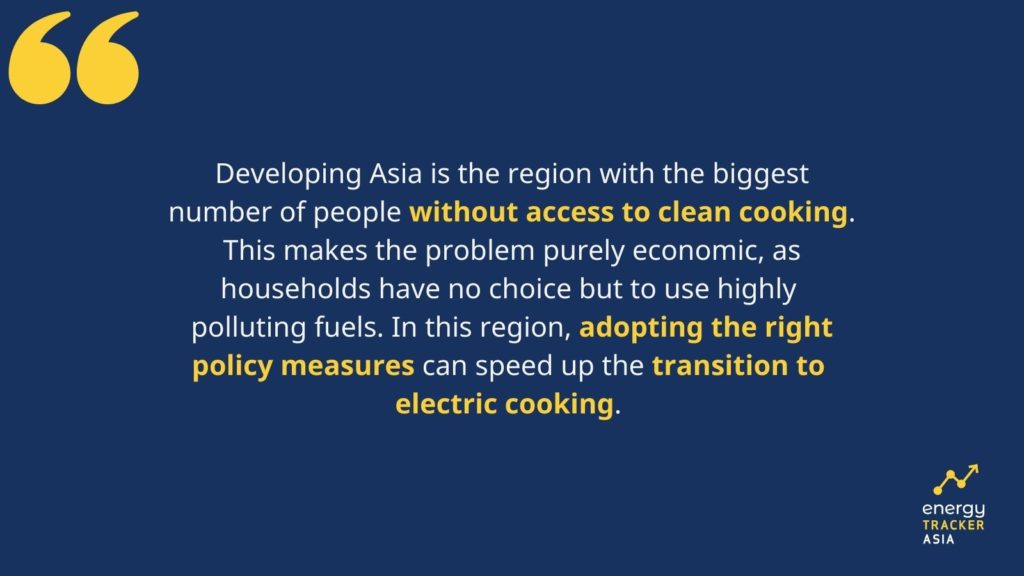The Outlook for Electric Cooking in Asia
Photo by Anurakss via ShutterStock
15 September 2022 – by Viktor Tachev Comments (0)
For electric cooking in Asia to go mainstream, governments need to help low and middle-income households move away from solid fuels and gas to modern energy and electric cooking appliances. Stimulating the transition to electric cooking can help households reduce their bills and ensure access to clean cooking fuels. Usage of clean cooking fuels will reduce household air pollution.
However, just a few countries are working in that direction. At the same time, many are promoting gas as the primary solution for clean cooking, despite the health and efficiency arguments against it.
What is the Preferred Cooking Energy Source in Asia?
In 1990, more than 75% of people in Central and Southern Asia mainly used solid fuels for cooking. For East and Southeast Asia, the figure was 50%.
Since then, Asia has made significant progress in the transition to clean cooking. However, around 600 million people on the continent will still be cooking with polluting fuels come 2030.

Today, most preferred cooking energy sources of developing countries of Asia are wood, natural gas and liquefied petroleum gas (LPG).
The poorest households rely predominantly on wood. Over 36% of the households in India and 35% of those in Pakistan rely on LPG. Gas is the dominant cooking fuel in countries like Malaysia and Thailand.
According to projections, gas and LPG, which are considered “clean cooking fuels” despite experts arguing the opposite, will remain the most widely used fuels for cooking in the East Asia and Pacific region no matter whether countries continue in a business-as-usual direction or succeed in ensuring universal electricity access.
At the same time, the share of electricity, which is the safest and most eco-friendly cooking fuel, is the least commonly used across low and middle-income countries in Asia today. Its use will remain negligible compared to gas, even in 2030.

Can the Status Quo Change?
Switching from solid to clean fuels for cooking is a matter of resources and willingness.
Studies conclude that countries in South Asia continue to rely mainly on traditional fuels for cooking due to energy poverty. Today, developing Asia is by far the region with the biggest number of people without access to clean cooking. This makes the problem purely economic, as households have no choice but to use highly polluting fuels. In this region, adopting the right policy measures can speed up the transition to electric cooking.
According to the IEA, which considers gas as a clean cooking fuel, most Asian countries have access to clean cooking. The continent registered the biggest clean energy gains in the past decade globally. Clean energy access is expected to reach 90% by 2030. As a result, switching to electric cooking isn’t a matter of resources but rather the willingness to abandon gas.

Gaining this willingness shouldn’t be too hard, considering the health risks and the high costs associated with gas cooking.
Changing the Landscape from Gas and Solid Fuels to Electric Cooking in Asia
According to the IEA, access to electricity in the region is sufficient. At the same time, natural gas pipeline infrastructure is significantly lacking in many parts of Asia.
Those factors open up the opportunity to shift from solid fuels and gas to electric cooking. To speed up the process, governments should educate the population on the benefits of the transition and subsidise poorer households. Southeast Asian leaders must also introduce more ambitious policies for clean cooking in line with a sustainable development scenario.

The incentive for a more ambitious push on the regulatory front is massive. Switching from solid fuels, gas and LPG to electricity will ensure access to more affordable and cleaner cooking – something that many households in low and middle-income Asian countries desperately need.
In fact, this transition is already gathering pace. Between 2021 and 2028, the Asia-Pacific will generate the fastest CAGR across the market for induction stoves – the most energy-efficient cooking technology available currently. Countries like China, India, South Korea and Japan will be the driving force behind that growth.
Using Gas for Cooking in Asia: History, Drawbacks And Future
Read moreThe Leaders and Laggards in Electric Cooking in Asia
Asia has examples of countries actively working to help their populations transition to electric cooking. At the same time, it is also home to many nations that remain firm in their use of gas.
India
India is exploring a hybrid model to leverage rooftop solar energy for cooking and reduce imports of costly fossil fuels. The plan aims to provide clean, uninterrupted electricity to around 250 million households. The government aims to sponsor the shift to induction cooking by providing stoves to poor households in rural and urban areas.
According to the IEEFA, utilising solar hybrid mini-grids for cooking can help increase the adoption of induction cookstoves and ease the transition to grid-connected electric cooking in the long run. What’s more, the IEEFA notes that most of these systems can also meet heating and lighting needs with clean energy.
Another advantage of the switch to electric cooking in India, according to the IEEFA, is that, at close to 100% electrification, the infrastructure is far ahead of that for natural gas and LPG.

Nepal
The country has a technical and economically feasible hydropower potential of 83 and 42 GW, respectively. This perfectly positions it for a switch to electric cooking. Yet, despite the high electricity access rates and clean energy potential, electric cooking has a negligible rate. The top 25% of the richest households use LPG, while the other 75% rely on solid fuels.
The government plans to change that through initiatives like the Nepal Alliance for Clean Cookstoves. The alliance unites organisations engaged in all renewable clean cooking technologies, including solar cookers, biogas and electric stoves. In 2017, Nepal also launched the Clean Cooking Solution for All (CCS4ALL) goal under the Sustainable Energy for All (SE4ALL) framework to promote clean cooking through various measures.
The government has already provided millions of cookstoves to households through cooperation with other governments, multilateral banks, and various UN organisations.
China
While China is leading clean energy technology development and adding renewables at unprecedented rates, the government has vigorously promoted a shift from coal to gas and is actively working in this direction.
Today, gas remains the preferred cooking fuel in the country. In rural areas, over 65% of households cook with gas. In some provinces, China continues to promote gas alongside electricity as alternatives to cooking with solid fuels.
The country can do much more to stimulate electric cooking, considering its vast clean energy capacity and resources. If China succeeds, it will champion yet another aspect of the global net-zero transition. While the transition to electric cooking might not be a priority for now, the willingness is probably there, considering that China has even gifted induction stoves to India in the past.
Indonesia
Indonesia is a bright example when it comes to electric cooking in Asia. The government is actively campaigning to encourage the utilisation of induction stoves and clean energy through an LPG-to-electric stove conversion program.
Officials acknowledge that not only will it help households switch to more affordable and cleaner cooking, but it will also benefit the state since it will allow it to save foreign exchange, increase economic growth and absorb domestic workers.
If the government addresses the existing perceptions in the community regarding the use of induction stoves, including willingness to access financing, perceived safety and perceived convenience, the programme’s success will increase significantly.
Japan
Japan’s expansive gas policy at the corporate and state level is well-documented. And cooking is no exception.
Over the years, Tokyo Gas has run numerous campaigns to speed up the transition to gas cooking.
The Top Runner Program, the government’s primary tool for stimulating appliance efficiency improvements, aims to promote the use only of the most energy-efficient technologies available on the market.
Judging by the numbers, these should be induction and electric cooking technologies. Induction transfers heat at 85% efficiency, with electric transferring heat at 75% to 80% efficiency. In comparison, the efficiency of gas is just 32%. Yet, despite this, Japan’s programme covers only gas appliances, while electric and induction stoves are omitted. This isn’t an intentional measure against all electric appliances, however. The programme covers electric refrigerators, freezers and even toilet seats.

by Viktor Tachev
Viktor has years of experience in financial markets and energy finance, working as a marketing consultant and content creator for leading institutions, NGOs, and tech startups. He is a regular contributor to knowledge hubs and magazines, tackling the latest trends in sustainability and green energy.
Read more



